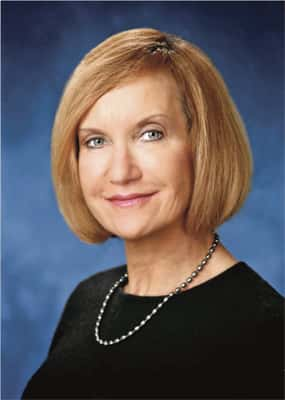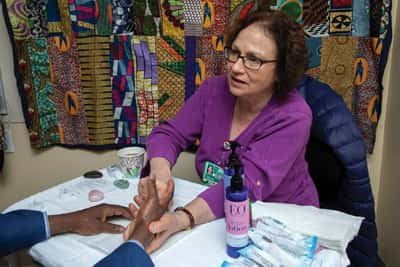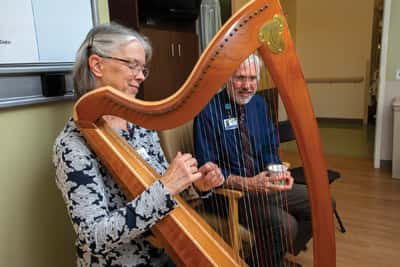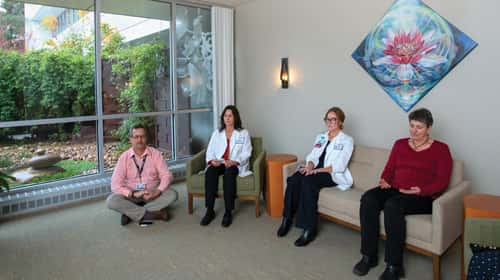If you’re not stressed at your job and workplace, consider yourself lucky. In a recent Gallup poll, 55 percent of Americans said they are stressed during the day, 20 percent higher than the world average of 35 percent. By comparison, the population of Greece is the most stressed out on the planet for the last several years (59 percent), but the United States is quickly catching up.
In a recent ranking by the Organization for Economic Cooperation and Development of its member nations, the U.S. didn’t even crack the top 10 for best work-life balance.
What are the warning signs of workplace stress, and when do you need to reach out for help? Peggy Ledner-Spaulding, manager of Outpatient Behavioral Health for St. Joseph Health in Sonoma County, says that lack of sleep is a major indicator of stress.
“How are you sleeping? Are you sleeping well or is your sleep interrupted? It can become a slippery slope because when you begin having sleep interruptions, you become more vulnerable,” she says. “A ‘startle’ response is another warning sign––you’re feeling irritable and snapping at people, and it’s hard to concentrate. You may notice difficulties with energy and motivation, and you can lose interest in the things that help you balance work and life. Losing interest in what you used to enjoy doing is an early warning sign of depression.”
Layers of stress
Persistent wildfire warnings, high-wind alerts, forced power outages, missed work, closed schools, and the largest evacuation in the history of Sonoma County in late October last year only escalated stress for many of us. And the drama didn’t end there, as another power shutoff put several thousand Sonoma County and North Bay residents in the dark again the week before Thanksgiving.
After all that’s happened, Ledner-Spaulding admits she continues to jump a little when a Nixle alert pops up on her phone. Still, she says, sometimes we all need to put down the phone and ignore the computer and set aside certain times to get information and input. “Being online so much only gets us all more spun up and anxious.”
Social media and texting is a double-edged sword with pros and cons, she explains. “People are much more closely connected now and they can share and offer support, but social media also becomes a preoccupation, to the point where we can get so obsessed with it that it’s hard to turn off. The exception, she adds, was the constant necessary alerts during the emergency created by the Kincade fire, “because residents were getting advance warnings and were kept connected with what was happening.”
The downside to all the preparation for disaster, says Ledner-Spaulding, is another level of stress that could involve loss of life or property. “Just when people were beginning to recover from the Tubbs fire and other wildfires, the Kincade fire brought it right back in our faces again. We continue to see an uptick in mental health issues and admissions because of the Tubbs fire, and every new fire event or power shutoff or evacuation adds a new layer of stress to already stressed people. Our behavioral health program sees a lot of PTSD [post-traumatic stress disorder], and even now when the wind kicks up, people get frightened. There are many triggers like that.”
Seeking professional help
The St. Joseph Outpatient Behavioral Health program provides two levels of care: a partial hospital program, and the intensive outpatient program. These are higher levels of care for people struggling with mental health issues. “Many workers take a medical leave from their job to participate in these programs and find they really need to, as they are not able to function to capacity in their workplace,” says Ledner-Spaulding. “We are seeing primarily a lot of depression and anxiety. Stress is impairing their ability to work, and this is how it impacts employers.”
 People cite heavy workloads, demanding bosses, and employers with unrealistic expectations as among their many job stressors, according to the American Institute of Stress. They also complain of a lack of support and camaraderie, and lack of teamwork. “Many times these employees believe that if they work hard they will be appreciated and respected,” she says. “Yet many times they don’t feel as if they are being seen or heard, that their opinion just doesn’t count. That can be even more stressful for them.”
People cite heavy workloads, demanding bosses, and employers with unrealistic expectations as among their many job stressors, according to the American Institute of Stress. They also complain of a lack of support and camaraderie, and lack of teamwork. “Many times these employees believe that if they work hard they will be appreciated and respected,” she says. “Yet many times they don’t feel as if they are being seen or heard, that their opinion just doesn’t count. That can be even more stressful for them.”
There may be other factors contributing to a person’s stress, but workplace stress is almost always at the top of the list, she says, in addition to relationship issues and financial stress.
Patients enter into the St. Joseph programs in groups to learn coping skills and stress management, or receive cognitive behavior therapy or dialectical behavior therapy. “These are treatments for recovery,” she adds. “St. Joseph has the most effective state-of-the-art practice in helping people, along with medications.”
Ledner-Spaulding says the outpatient behavioral health programs are treating an equal number of women and men. “More men are entering the programs than ever before. It used to be predominately women, but that’s changing.”
Working with the community
 Chaplain Raymond Dougherty, director of spiritual care for Kaiser Permanente Marin-Sonoma, believes that Employee Assistance Programs (EAPs) at some companies may be underutilized for helping to deal with workplace stress. “An EAP is a powerful benefit that many people don’t realize they have, and it’s usually available for themselves and their immediate families.”
Chaplain Raymond Dougherty, director of spiritual care for Kaiser Permanente Marin-Sonoma, believes that Employee Assistance Programs (EAPs) at some companies may be underutilized for helping to deal with workplace stress. “An EAP is a powerful benefit that many people don’t realize they have, and it’s usually available for themselves and their immediate families.”
Several programs that were originally created at Kaiser hospitals for their staffs to help relieve stress are now available to anyone in the community, not just Kaiser members. Kaiser is one of many local organizations that became active in the Sonoma Community Resilience Collaborative, established following the Tubbs fire to help everyone in the community deal with the stressful aftermath.
The collaborative trained many people in Sonoma County to helm workshops and classes aimed at reducing stress. The workshops are usually free, or have a small fee, and most are conducted at small venues within the community. “The best thing is to bring people together to share. These events introduce resiliency skills for people who need them––that’s what it’s for, to experience self-care practices together and develop mind-body skills,” says Dougherty.
 Kaiser implemented in-house programs at both of its local hospitals in Santa Rosa and San Rafael, which aimed to help staff deal with stress and burnout from their health-care jobs. Dougherty and other chaplains are also available to sit with stressed workers when they need someone to listen. “I was just talking to a staff member who had been through a traumatic personal event,” he says. “She was rattled, her manager could see that, and asked if she wanted to talk to a chaplain. She unloaded about a lot of the things troubling her and felt so much better after sharing it. She stepped away from her job for just a little while, and then finished her shift. That type of balance within the workflow is important.”
Kaiser implemented in-house programs at both of its local hospitals in Santa Rosa and San Rafael, which aimed to help staff deal with stress and burnout from their health-care jobs. Dougherty and other chaplains are also available to sit with stressed workers when they need someone to listen. “I was just talking to a staff member who had been through a traumatic personal event,” he says. “She was rattled, her manager could see that, and asked if she wanted to talk to a chaplain. She unloaded about a lot of the things troubling her and felt so much better after sharing it. She stepped away from her job for just a little while, and then finished her shift. That type of balance within the workflow is important.”
Learning self-care
Dougherty says he frequently assists departments at Kaiser that may be having issues, such as low morale. “We sit down with the staff workers and help them process and voice their feelings. We draw out the inner wisdom of the group, and some of the brainstorming is revelatory. We create a sacred space where workers can share without fear of retaliation, and we try to take a diversity of approaches to self-care.”
He usually asks workers to describe their spiritual self-care for fighting stress. Their responses range from cooking to walking their dog, taking a yoga class, or sinking into a hot tub to calm the nerves and regain a perspective on their workday. “To help staff calm down and identify [stress] triggers, we conducted a series of self-compassion workshops—introducing the practice of taking five-minute self-compassion breaks in the course of their work for a needed time out. “So when you get that one email that winds you up, take a short, self-compassion break. If you can come together as a team, it’s even more effective.”
A program Kaiser first rolled out in 2018 for its workers in Marin and Sonoma is “Tea for the Soul,” a twice-monthly opportunity for any staff member to drop in to a calming space such as a dimly-lit conference room, or an empty patient room. Tea and cookies are offered to make it a soothing place for workers to pop in for a few minutes as needed. “This could easily be adapted by any company wanting to offer their workers some self-care support,” says Dougherty.
Another self-care option at Kaiser’s Santa Rosa campus is a drop-in mindfulness group that meets every Wednesday in the hospital’s meditation room. It’s open to anyone. People spend their time meditating silently, and then join in optional group sharing.
Dougherty recently conducted a workshop that focused on PTSD and, more importantly, what he calls “post-traumatic growth,” which he says occurs at the same time we are distressed. “People light up when we describe it, and they realize how they’re experiencing more gratitude for what they have,” he says. “Even though traumatized by the fires, for instance, they’re often also experiencing a wellspring of gratitude. People are reconnecting with their spirituality in different ways. They are finding a greater sense of personal strength.”
The mind-body connection
 What can stressed-out workers do to get back on track? “Keep balance in your life,” says Ledner-Spaulding. “Make down time away from the job where you get some exercise and have social interactions. We work with our patients on visualizing their ‘wheel of wellness’ and how to balance their ride. Good nutrition and exercise are major factors in relieving job stress. In the workplace, practice mindfulness and be present in the moment. Don’t spend too much time watching the news on your devices, and balance your thinking so it’s not all ‘what ifs.’”
What can stressed-out workers do to get back on track? “Keep balance in your life,” says Ledner-Spaulding. “Make down time away from the job where you get some exercise and have social interactions. We work with our patients on visualizing their ‘wheel of wellness’ and how to balance their ride. Good nutrition and exercise are major factors in relieving job stress. In the workplace, practice mindfulness and be present in the moment. Don’t spend too much time watching the news on your devices, and balance your thinking so it’s not all ‘what ifs.’”
Additionally, people must set emotional boundaries so they don’t take on everyone else’s negative energy, she says. “Shallow breathing makes us more stressed, so take deep breaths as often as possible. Use your designated breaks to get some fresh air when you can. Go for a short walk. You need to move your body because the mind and body are all connected. It also helps to get emotional support from work colleagues and be open to letting others help you.”
Winter can also be a difficult time of the year for many people who suffer from seasonal affective disorder. “It can be another layer of stress on top of stress,” says Ledner-Spaulding.
Meanwhile, business owners and managers need to take a hard look at what they are doing to help their stressed workers, says Dougherty. “If employers don’t address the humanity of their workforce and it’s only about productivity, there will be issues, then there may be more difficult issues down the line.”





